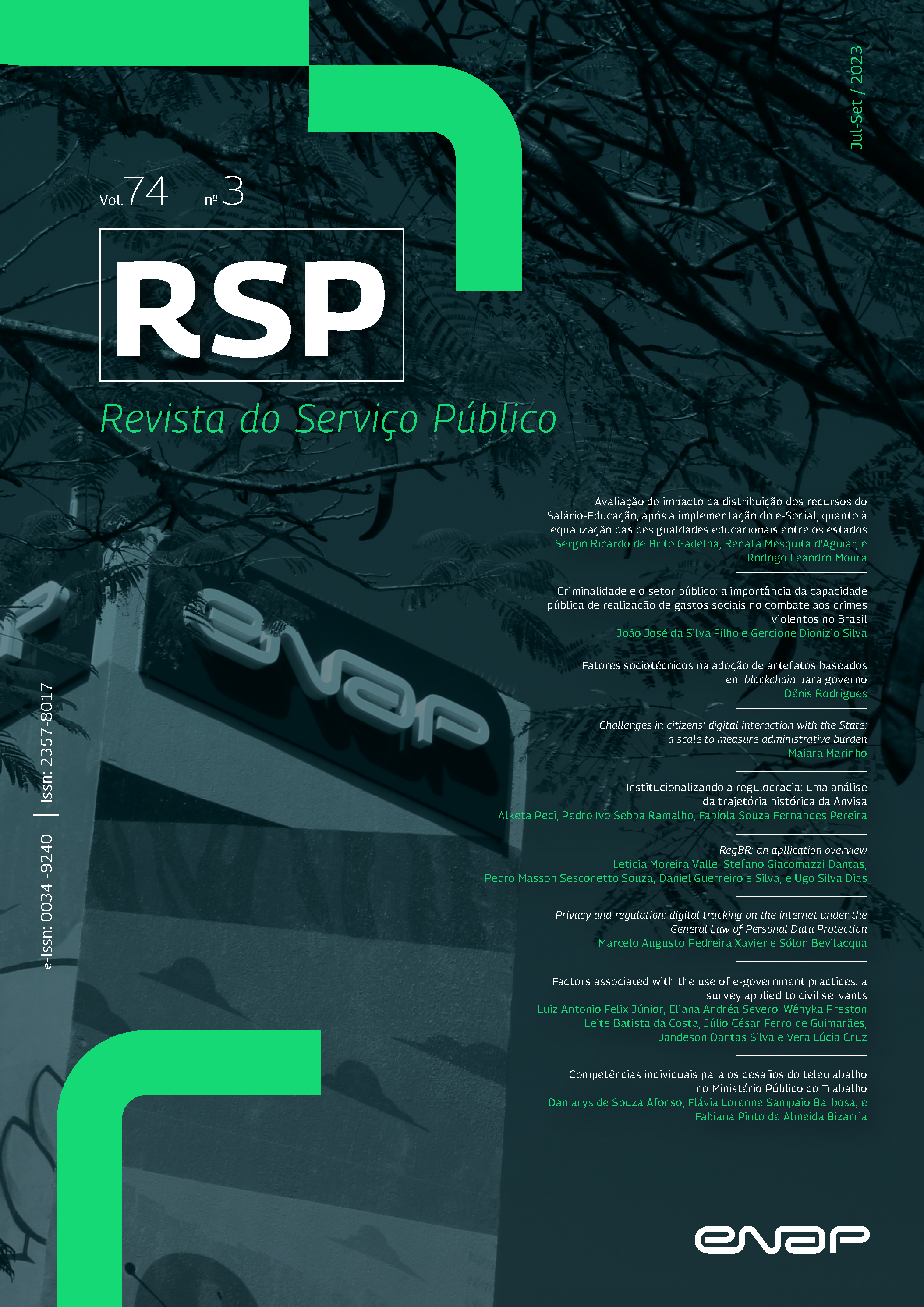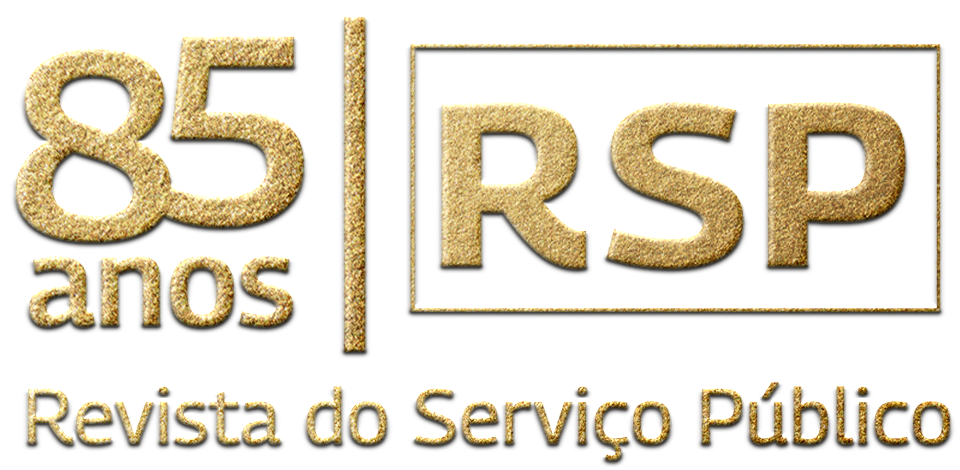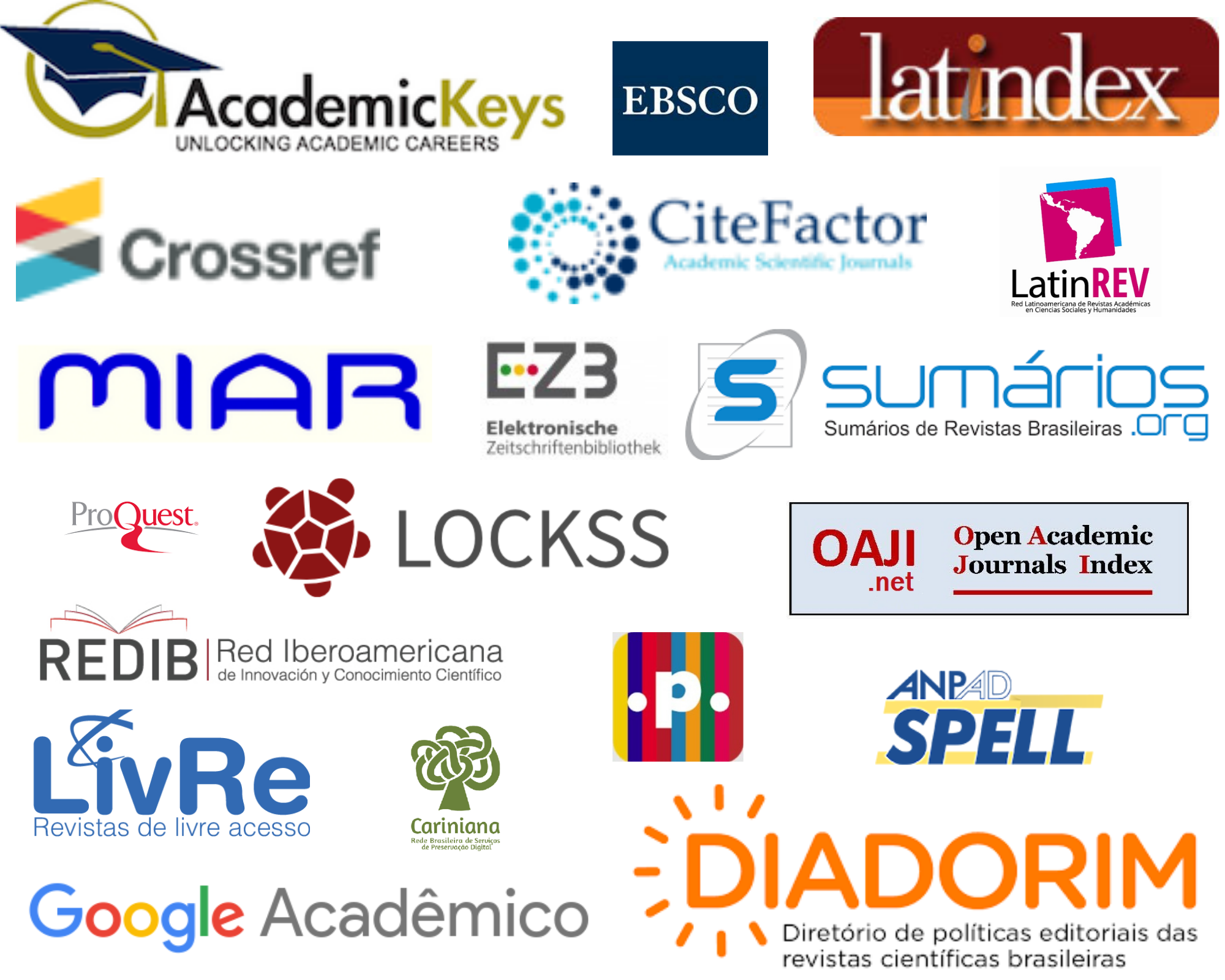Fatores associados à utilização de práticas de governo eletrônico: uma pesquisa aplicada a servidores públicos
una encuesta aplicada a servidores públicos
Palavras-chave:
governo eletrônico, servidor público, intenção de usoResumo
A pesquisa objetivou verificar os fatores determinantes para a utilização de práticas de governo eletrônico, perante a percepção dos servidores públicos. Para a realização do estudo, foi utilizado um questionário com escala de avaliação Likert de cinco pontos. Os dados foram analisados através da estatística descritiva, análise fatorial confirmatória e regressão linear múltipla, que avaliou 5 hipóteses de pesquisa. A amostra do estudo contou com 206 servidores federais e estaduais da região nordeste do Brasil. Foi confirmado que expectativa de esforço e desempenho, condições facilitadoras e inclusão social são aspectos que influenciam na intenção de uso do governo eletrônico, já a hipótese da capacidade inovadora foi refutada, alertando que o servidor não precisa ter um perfil empreendedor para adotar práticas modernas. Ainda, constatou-se que o fator da influência social é o que apresenta maior poder de influência positiva sobre a intenção de uso, demonstrando que o meio em que vive incentiva o uso de práticas eletrônicas.
Downloads
Referências
Abu-Shanab, E., & Shehabat, I. (2018). The influence of knowledge management practices on e-government success: A proposed framework tested. Transforming Government: People, Process and Policy, 12 (3/4), 286-308, 2018
Agarwal, U. A., Datta, S., Blake-Beard, S., & Bhargava, S. (2012). Linking LMX, innovative work behaviour and turnover intentions: The mediating role of work engagement. Career development international, 17(3), 208-230.
Ahn, M. J. (2011). Adoption of e-communication applications in US municipalities: The role of political environment, bureaucratic structure, and the nature of applications. The American Review of Public Administration, 41(4), 428-452.
Al-Rababah, B. A., & Abu-Shanab, E. A. (2010). E-government and gender digital divide: The case of Jordan. International Journal of Electronic Business Management, 8(1), 1-8.
Amanda, N. F. P. (2019). E-Government as Public Sector Innovation. Journal of Public Administration Studies, 4(2), In Press.
Baptista, M. V. (2000). Planejamento social: intencionalidade e instrumentação. Ed. 2, Veras, São Paulo.
Bhatia, K. (2020). E-Government and E - Governance: issues and Challenges. Our Heritage, 68(9), 800–808.
Batara, E., Nurmandi, A., Warsito, T., & Pribadi, U. (2017). Are government employees adopting local e-government transformation? The need for having the right attitude, facilitating conditions and performance expectations. Transforming Government: People, Process and Policy, 11 (4), 612-638.
Ben, E. R., & Schuppan, T. (2014). E-Government Innovations and Work Transformations: Implications of the introduction of electronic tools in public government organizations. International Journal of Electronic Government Research (IJEGR), 10(1), 1-17.
Budiati, A. (2018). E-Government and E-Governance: can its improve indonesian public service deliveries?. Iapa Proceedings Conference, [S.l.], 392-404. Recuperado em 17 março, 2020, de https://journal.iapa.or.id/proceedings/article/view/212
Costa, F. J. (2011). Mensuração e desenvolvimento de escalas. Editora Ciência Moderna Ltda, Rio de Janeiro.
Curristine, T., Lonti, Z., & Joumard, I. (2007). Improving public sector efficiency: Challenges and opportunities. OECD Journal on Budgeting, 7(1), 161.
De Guimarães, J. C. F., Severo, E. A., Felix Júnior, L. A., Da Costa, W. P. L. B., & Salmoria, F. T. (2020). Governance and quality of life in smart cities: Towards sustainable development goals. Journal of Cleaner Production, 253, 119926.
De Guimarães, J. C. F., Severo, E. A., & de Vasconcelos, C. R. M. (2018). The influence of entrepreneurial, market, knowledge management orientations on cleaner production and the sustainable competitive advantage. Journal of cleaner production, 174, 1653-1663.
Domínguez, L. R., Sánchez, I. M. G., & Álvarez, I.G (2011). Determining factors of e-government development: A worldwide national approach. International Public Management Journal, 14(2), 218-248.
Downing, J. C. D. (2011). Estatística aplicada. Editora Saraiva.
European Parliament. (2014). Mapping smart cities in the EU. Brussels, Belgium: European Parliament, Directorate General for internal policies. Recuperado de europarl.europa.eu/RegData/etudes/etudes/join/2014/507480/IPOLITRE_ET(2014)507480_EN.pdf
Freitas, H., Oliveira, M., Saccol, A. Z., & Moscarola, J. (2000). O método de pesquisa survey. Revista de Administração da USP, 35(3), 105-112.
Gaikwad, N. N. (2020). M-Governance in India: Problems and Strategies. Our Heritage, 68(9), 1136 – 1140.
Gil-García, J. R., & Pardo, T. A. (2005). E-government success factors: Mapping practical tools to theoretical foundations. Government information quarterly, 22(2), 187-216.
Hair, J. F., Black, W. C., Babin, B. J., & Anderson, R. E. (2010). Multivariate data analysis: Pearson new international edition. Pearson Higher Ed.
Hartley, J. (2013). Public and private features of innovation. Handbook of innovation in public services, 44-59.
Hsu, M., Hou, S., & Fan, H. (2011). Creative self‐efficacy and innovative behavior in a service setting: Optimism as a moderator. The Journal of Creative Behavior, 45(4), 258-272.
Im, T., Cho, W., Porumbescu, G., & Park, J. (2012). Internet, trust in government, and citizen compliance. Journal of Public Administration Research and Theory, 24(3), 741-763.
Janowski, T., Pardo, T. A., & Davies, J. (2012). Government information networks-mapping electronic governance cases through public administration concepts. Government Information Quarterly, 29(1), S1-S10.
Janssen, O. (2000). Job demands, perceptions of effort-reward fairness and innovative work behaviour. Journal of Occupational and Organizational Psychology, 73(3), 287–302.
Janssen, M., Rana, N. P., Slade, E. L., & Dwivedi, Y. K. (2018). Trustworthiness of digital government services: deriving a comprehensive theory through interpretive structural modelling. Public Management Review, 20(5), 647-671.
Jun, K. N., & Weare, C. (2010). Institutional motivations in the adoption of innovations: The case of e-government. Journal of Public Administration Research and Theory, 21(3), 495-519.
Kumar, R., Sachan, A., & Mukherjee, A. (2017). Qualitative approach to determine user experience of e-government services. Computers in Human Behavior, 71, 299-306.
Lam, W. (2005). Barriers to e-government integration. Journal of Enterprise Information Management, 18(5), 511-530.
Leonnel, A. C. M., Tonelli, D. F., Leme, P. H. M. V., & Amâncio, J. M. (2018). Limites e Possibilidades da Interação Sociopolítica entre Sociedade e Câmara dos Deputados pelo Portal Eletrônico e-Democraciai. Administração Pública e Gestão Social, 10(3), 212-221.
Liu, S. M., & Yuan, Q. (2015). The evolution of information and communication technology in public administration. Public Administration and Development, 35(2), 140-151.
Manoharan, A. P., Ingrams, A., Kang, Dongyoen, & Zhao, H. (2020). Globalization and Worldwide Best Practices in E-Government, International Journal of Public Administration, 1 –12, In Press. Doi: 10.1080/01900692.2020.1729182
Manoharan, A. P., & Ingrams, A. (2018). Conceptualizing e-government from local government perspectives. State and Local Government Review, 50(1), 56-66.
Marôco, J. (2010). Análise de equações estruturais: Fundamentos teóricos, software & aplicações. ReportNumber, Lda.
Mazzucato, M. (2013). The entrepreneurial state: Debunking public vs. private sector myths (Vol. 1). Anthem Press.
Meijer, A., & Bolívar, M. P. R. (2016). Governing the smart city: a review of the literature on smart urban governance. International Review of Administrative Sciences, 82(2), 392-408.
Morgan, J. Q. (2010). Governance, policy innovation, and local economic development in North Carolina. Policy Studies Journal, 38(4), 679-702.
Norris, D. F., & Reddick, C. G. (2013). Local e‐government in the United States: Transformation or incremental change?. Public Administration Review, 73(1), 165-175.
Nulhusna, R., Sandhyaduhita, P. I., Hidayanto, A. N., & Phusavat, K. (2017). The relation of e-government quality on public trust and its impact on public participation. Transforming Government: People, Process and Policy, 11(3), 393-418.
Paese, C., Caten, C., & Ribeiro, J. L. D. (2001). Aplicação da análise de variância na implantação do CEP. Revista Produção, 11(1), 17-26.
Park, S., & Jo, S. J. (2018). The impact of proactivity, leader-member exchange, and climate for innovation on innovative behavior in the Korean government sector. Leadership & Organization Development Journal, 39(1), 130-149.
Pereira, V. P., Martins, V. F., & Maia, L. C. C. (2011). O Papel das Âncoras na Aceitação da Tecnologia da Informação: Um Estudo de Caso da Substituição de um Sistema de Informação Gerencial. Anais do XXXV Encontro do Anpad - ENANPAD, Rio de Janeiro, RJ, Brasil, 35.
Poonam, Verma, P., & Vats, S. K. (2020). Role of Ict in E-Governance and Rural Development in India. Studies in Indian Place Names (UGC Care Journal), 40 (3), 3610– 3620.
Potnis, D. D. (2010). Measuring e-Governance as an innovation in the public sector. Government Information Quarterly, 27(1), 41-48.
Ramírez-Alujas, A. (2016). Laboratorios de gobierno como plataformas para la innovación pública. In G.M. Cejudo, M.I.D. Laguna, & C. Michel (Orgs.). La innovación en el sector público: Tendencias internacionales y experiencias mexicanas, 163-203. Ciudad de México: Instituto Nacional de Administración Pública.
Rana, N. P., Dwivedi, Y. K., Williams, M. D., & Weerakkody, V. (2015). Investigating success of an e-government initiative: Validation of an integrated IS success model. Information Systems Frontiers, 17(1), 127-142.
Rey-Moreno, M., Felício, J. A., Medina-Molina, C., & Rufín, R. (2018). Facilitator and inhibitor factors: Adopting e-government in a dual model. Journal of Business Research, 88, 542-549.
Severo, E. A., De Guimarães, J. C. F., & Dorion, E. C. H. (2018). Cleaner production, social responsibility and eco-innovation: Generations' perception for a sustainable future. Journal of Cleaner Production, 186, 91-103.
Shim, D. C., & Eom, T. H. (2008). E-government and anti-corruption: Empirical analysis of international data. Intl Journal of Public Administration, 31(3), 298-316.
Setiawan, A. I., Nguyen, P. T., Perumal, E., Shankar, K., Abadi, S., Hashim, W., & Maseleno, A. (2019). Village’s E-Government Ade Irfan Setiawan. International Journal of Engineering and Advanced Technology, 8 (6S2), 1026–1029.
Thurlings, M., Evers, A. T., & Vermeulen, M. (2015). Toward a model of explaining teachers’ innovative behavior: a literature review. Review of Educational Research, 85(3), 430-471.
Venkatesh, V., Morris, M. G., Davis, G. B., & Davis, F. D. (2003). User acceptance of information technology: Toward a unified view. MIS quarterly, 27(3), 425-478.
Wang, S., & Feeney, M. K. (2016). Determinants of information and communication technology adoption in municipalities. The America Review of Public Administration, 46, 292–313.
Wooldridge, J. M. (2006). Introductory econometrics: a modern approach, 3rd. New York: Thomson.
Wong, C. H., Tan, G. W. H., Tan, B. I., & Ooi, K. B. (2015). Mobile advertising: the changing landscape of the advertising industry. Telematics and Informatics, 32(4), 720-734.
Yuan, F., & Woodman, R. W. (2010). Innovative behavior in the workplace: the role of performance and image outcome expectations. Academy of management journal, 53(2), 323-342.
Downloads
Publicado
Como Citar
Edição
Seção
Licença
Copyright (c) 2023 Revista do Serviço Público

Este trabalho está licenciado sob uma licença Creative Commons Attribution-NonCommercial-ShareAlike 4.0 International License.
- A RSP adota a licença Creative Commons (CC) do tipo Atribuição – Uso Não-Comercial (BY-NC).
- A licença permite que outros remixem, adaptem e criem obra licenciada, sendo proibido o uso com fins comerciais.
- As novas obras devem fazer referência ao autor nos créditos e não podem ser usadas com fins comerciais, porém não precisam ser licenciadas sob os mesmos termos dessa licença.
- Ao publicar o artigo na RSP, o autor cede e transfere para a ENAP os direitos autorais patrimoniais referentes ao artigo.
- O artigo publicado na RSP não poderá ser divulgado em outro meio sem a devida referência à publicação de origem.
- O autor que tiver o artigo publicado na RSP deverá assinar o Termo de Concessão de Direitos Autorais (em momento oportuno a editoria da Revista entrará em contato com o autor para assinatura do Termo).



